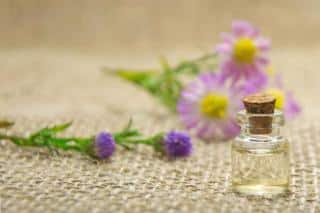

With hint of agastache in its appearance, hyssop is a garden favorite thanks to its fragrant blue flower panicles. And there’s much more! The benefits of this medicinal plant helps treat a number of ENT disorders, digestive problems, and anxiety.
Let’s focus on this easy-to-grow plant and its many benefits.
 Just like lavender, hyssop is a low-growing perennial shrub. It grows naturally in dry environments, specifically in the Mediterranean region. Its bearing is structured by tall, upright stems that are sparsely adorned with thin delicate leaves, akin to those of aromatic herbs.
Just like lavender, hyssop is a low-growing perennial shrub. It grows naturally in dry environments, specifically in the Mediterranean region. Its bearing is structured by tall, upright stems that are sparsely adorned with thin delicate leaves, akin to those of aromatic herbs.
Somewhat similar to mint, leafage is semi-evergreen, meaning it survives light frosts but dies off when it freezes for days on end.
A charming feature is the intense violet-blue blooming that appears from July to September. Some varieties have pink, red or even white flowers.
 Hyssop favors rich, well-drained substrates in full sun. It also can make do with part sun, but full sun will really let it thrive and help increase its hardiness in Winter. You can choose to either plant it directly in the ground or in pots. Pots and containers must be large enough to have a nice layer of drainage materials at the bottom. The planting of this bush should take place in Fall. Sowing, on the other hand, should be done in Spring under a cold frame. Here are the steps for planting directly in the ground:
Hyssop favors rich, well-drained substrates in full sun. It also can make do with part sun, but full sun will really let it thrive and help increase its hardiness in Winter. You can choose to either plant it directly in the ground or in pots. Pots and containers must be large enough to have a nice layer of drainage materials at the bottom. The planting of this bush should take place in Fall. Sowing, on the other hand, should be done in Spring under a cold frame. Here are the steps for planting directly in the ground:
 Don’t plant anything in a two-foot circle around your hyssop (50 to 60 cm). Water lightly, and only during the growing phase or when it hasn’t rained for a long time. Normally, though, you won’t need to water, since even irregular rainfall will satisfy the plant!
Don’t plant anything in a two-foot circle around your hyssop (50 to 60 cm). Water lightly, and only during the growing phase or when it hasn’t rained for a long time. Normally, though, you won’t need to water, since even irregular rainfall will satisfy the plant!
These soft, young stems are the parts of the plant to use for their therapeutic benefits.
Hardiness – Hyssop tolerates 5°F (-15°C), so regions that are any colder will have to grow them in pots to overwinter it indoors.
 Hyssop displays tonic, antiseptic, expectorant, digestive, antifungal and anti-asthma properties and activity. It’s uses include treating rhinitis, bronchitis, otitis and sinusitis, and it also helps regulate the digestive flow. It even has the capacity to lower fever. Generally, diseases that call for its use are the flu and pulmonary ailments.
Hyssop displays tonic, antiseptic, expectorant, digestive, antifungal and anti-asthma properties and activity. It’s uses include treating rhinitis, bronchitis, otitis and sinusitis, and it also helps regulate the digestive flow. It even has the capacity to lower fever. Generally, diseases that call for its use are the flu and pulmonary ailments.
It is also recommended to better deal with stress, recover from extreme fatigue, and lighten up your mood when depressive thoughts take hold. Hyssop used topically will help wounds to heal, and spreading some around joints will reduce pain due to rheumatism.
To treat ENT disorders and early flu symptoms, one should prepare an infusion from the tips of flowers. Fresh ones can be used, but it also works with dried ones. Steep 10 g of hyssop in 1 quart or liter boiling water. Swallow a few gulps of this brew several times a day for a week.
A few drops of this plant’s appeasing essential oil in the bathwater will favor relaxation. This will certainly help soothe anxiety and stress, and will stave off depression.
Place 10g of leaves and flowers in 2 pints (50 cl) water. Bring to a boil then let steep for 15 minutes. Use this solution to gargle. Doing so will relieve infection on soft tissues around the pharynx and throat.
To clear your skin from traces of bruising after bumping yourself somewhere, you’ll need to use the leaves. Chop them to a paste, pile the paste on the bruise, and cover with a cloth or bandage. Tie the bandage in place for 1 to 2 hours.
 Whether it’s taken through a scent vaporizer, inhaled, or rubbed onto the skin, hyssop essential oil will help deal with ENT and emotional troubles.
Whether it’s taken through a scent vaporizer, inhaled, or rubbed onto the skin, hyssop essential oil will help deal with ENT and emotional troubles.
Follow the doses written on the box and labels, and check with your Doctor or Pharmacist. Hyssop is not recommended for hyperactive persons and pregnant or breast-feeding women. Indeed, when it isn’t properly dosed, it may trigger convulsions and have abortive effects.